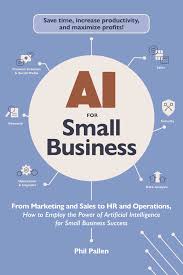Executive Summary
In an increasingly digital economy, Small and Medium Enterprises (SMEs) must adopt cutting-edge technologies such as Artificial Intelligence (AI), Machine Learning (ML), and robust Information Systems (IS) to gain and sustain competitive advantage. This white paper presents a professional, strategy-driven approach based on Porter’s competitive models and offers insights from leading resources. It also outlines how IAS-Research.com and KeenComputer.com help SMEs overcome barriers, especially in the context of Canadian economic challenges such as tariffs and a potential downturn.
Leveraging IT, AI, and Machine Learning as Strategic Enablers for SME Growth
Executive Summary
In an increasingly digital economy, Small and Medium Enterprises (SMEs) must adopt cutting-edge technologies such as Artificial Intelligence (AI), Machine Learning (ML), and robust Information Systems (IS) to gain and sustain competitive advantage. This white paper presents a professional, strategy-driven approach based on Porter’s competitive models and offers insights from leading resources. It also outlines how IAS-Research.com and KeenComputer.com help SMEs overcome barriers, especially in the context of Canadian economic challenges such as tariffs and a potential downturn.
Curated Books and Resources for SME AI Strategy
- AI for Small Business by Phil Pallen
- Offers actionable frameworks and real-world case studies on leveraging AI for automation, decision-making, and scale.
- Strategic Fit: Aligns with differentiation and cost leadership by enhancing personalized customer experiences and lowering operational expenses.
- Practical Deep Learning, 2nd Edition by Ronald T. Kneusel
- Introduces practical tools and workflows using Python, Keras, and PyTorch to deploy AI in vision systems, analytics, and generative models.
- Strategic Fit: Supports value chain optimization across logistics, operations, and human resource planning.
- Artificial Intelligence for Small Business (Applify eBook)
- Emphasizes resource-efficient AI strategies for customer engagement, process automation, and data analytics.
- Strategic Fit: Enables focus strategies by empowering niche market targeting through predictive analytics and segmentation.
- Information Systems Strategy and SMEs (Peer-reviewed paper)
- Advocates aligning IT strategies with enterprise goals via SWOT, PEST, and Value Chain analysis.
- Strategic Fit: Directly supports Porter’s Five Forces by helping SMEs respond to competitive pressure using IS frameworks.
Strategic Enablers from IAS-Research.com and KeenComputer.com
|
Strategic Function |
IAS-Research.com |
KeenComputer.com |
Porter Model Alignment |
|---|---|---|---|
|
IT & AI Planning |
Conducts SWOT, feasibility, and digital readiness assessments |
Crafts AI integration roadmaps aligned to business strategy |
Cost Leadership, Differentiation |
|
AI Development |
Research-grade model testing and compliance validation |
Custom development of AI tools like vision and prediction |
Value Chain & Focus Strategy |
|
Operational Automation |
Builds decision support and forecasting systems |
Implements AI chatbots, dashboards, and automation scripts |
Operational Effectiveness, Process Innovation |
|
Scalable Innovation |
Co-develops proof-of-concept for emerging tech applications |
Rapid prototyping and deployment of SME-targeted solutions |
Differentiation, Niche Exploitation |
Canadian SME Context: Challenges and Opportunities
Key Threats to Canadian SMEs:
- Tariffs and Trade Barriers: Rising costs on imported raw materials and electronics reduce margins and impact global competitiveness.
- Economic Decline: Inflation, interest rate hikes, and weak global demand lead to reduced consumer spending and investment.
- Regulatory Complexity: Stringent Canadian privacy and data governance laws increase compliance costs for digital initiatives.
Strategic Recommendations:
- Risk Diversification: Use predictive analytics and scenario planning to mitigate tariff-related supply chain disruptions.
- Resilience Planning: Deploy AI tools to improve cash flow forecasting and maintain lean operations during downturns.
- Compliance by Design: Build AI and IT solutions with embedded privacy and ethical safeguards.
Porter’s Strategic Integration for SMEs
Competitive Advantage
Strategically applied AI reduces costs via automation (e.g., invoice processing) and enhances differentiation through real-time personalization (e.g., marketing, user experience).
Value Chain Optimization
From AI-enhanced logistics and customer service (primary activities) to data-driven HR and procurement (support activities), firms can streamline their value chains.
Five Forces Resilience
- Barriers to Entry: Proprietary AI tools and analytics deepen moats.
- Buyer Power: Dynamic pricing and personalization improve conversion.
- Supplier Power: Data-backed sourcing mitigates tariff effects.
Visual Strategy Matrix (Porter’s Generic Strategies)
|
Market Scope |
Cost Leadership |
Differentiation |
Focus Strategy |
|---|---|---|---|
|
Broad |
AI-driven back-office automation (finance, logistics) |
AI-powered customer insights and personalization at scale |
N/A |
|
Narrow (Niche) |
Vertical-specific IT solutions (e.g., retail, manufacturing) |
Custom AI for local market needs (e.g., food, fashion) |
Predictive analytics for localized service optimization |
SWOT Analysis of AI & IT Strategy for SMEs
|
Strengths |
Weaknesses |
|---|---|
|
- Improved strategic decision-making via data analytics |
- Budgetary constraints limit investment in advanced technologies |
|
- Enhanced productivity and process automation |
- Talent shortages in AI development and data engineering |
|
- Greater customer acquisition through personalization |
- Overdependence on third-party AI vendors |
|
- Access to scalable cloud-based platforms |
- Increased cybersecurity risks and regulatory complexity |
|
Opportunities |
Threats |
|---|---|
|
- Government grants for digital adoption (e.g., IRAP) |
- Rising operational costs due to tariffs and inflation |
|
- Partnerships with AI and IT consultancies |
- Global economic slowdown reducing capital availability |
|
- Entry into underserved or underserved digital markets |
- Competitive pressure from digital-native entrants |
Conclusion
Canadian and global SMEs must embrace AI, IT, and Machine Learning not only as tools but as integral components of their long-term strategy. With growing threats from tariffs, economic downturns, and digital-native competition, SMEs require agile, ethical, and scalable solutions. By leveraging frameworks like Porter’s competitive strategies and collaborating with experienced partners such as IAS-Research.com and KeenComputer.com, SMEs can future-proof their operations, drive innovation, and sustainably scale in a challenging business environment.
